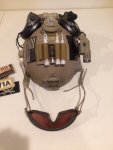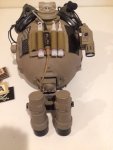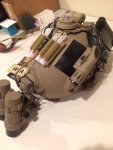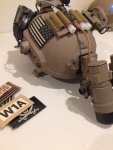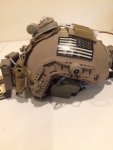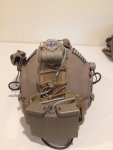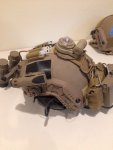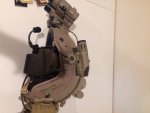You don't need a IIIA ballistic; they're heavier and they aren't really meant to stop bullets. While they actually have on occassion, ballistic helmets are designed to protect you from high speed flying debris.
As a NV host, get a polymor bump helmet with a good suspension and pad system. I have a Crye Airframe, Ops Core Martime and a custom Ops Core Maritime high cut polymor; I wear the lighter bump helmet 99% of the time. With that said, do not buy the helmets with the molded in shroud.
My helmet setups are almost identical outside of the differences in what the actual NV units need to have on the helmet (PVS14, dual NV/thermal, ANVIS9).
The helmet I use the most if the polymor maritime with Ops Core suspension, 4D tactical helmet pads and ARC rails.
ANVIS9 in the ITT ANVIS 9 mount
Mohawk counter weight in rear with ANVIS9 battery pack attached to it via the battery pack velcro and dummy cord
Batteriescounterweight inside mohawk (weigh your batteries, figure out what you need to replace everything youd run once and take enough of the right batteries to do so; try to have redundant battery needs as much as possible)
On the rear almost to the top of my helmet is a VIP 3 setting light (IR flash, IR on, green light on)
Infront of the VIP light, more forward is a mini chemlight holder for 5x IR chemlights as well as used to route the ANVIS cable through towards the rear
Peltor COMTACH w/mic on ARC rail mounts; PTT cord is stowed in mohawk if not in use
Inforce IR/white light weapon light on my left (weak) side on a pic rail mount in the ARC rail
Smith Optics 'boogie' mounts on the bottom of each ARC rail incase I need to wear my ballistic face shield
Here, this should make more sense with pics now. Only thing that changes on this helmet is the color of ballistics face shield (clear at night, red during the day) and whats in the counterweight pouch if the battery pack and ANVIS unit is stowed.
